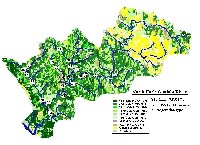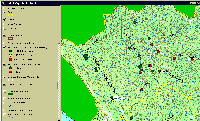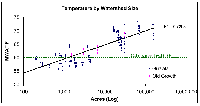| Area | North Fork |
| Topic | Temperature: Maximum Floating Weekly Average (F) NF Gualala 1994-2001 |
The image of the North Fork Gualala showing vegetation and MWAT (F) by location are from the North Coast Regional Water Quality Control Board. Vegetation information is satellite derived from the USFS Spatial Analysis Lab in Sacramento. Maximum floating weekly average water temperature in Fahrenheit are the maximum values for all years measured. The North Fork cools as it moves west off melange terrain from 72 F to 65 F below Robinson Creek but warms again above its convergence with the Little North Fork. An MWAT of 62.25 F is the maximum threshold for supporting coho juveniles (Welsh et al., 2001).
The map above comes from the KRIS Gualala Map project and shows the maximum floating weekly average water temperatures of the North Fork Gualala and its tributaries based on data provided by Gualala Redwoods Inc and the Gualala River Watershed Council. The Little North Fork, Robinson and most locations in Dry Creek recorded fully functional conditions for salmonids. Coho do not inhabit streams with an MWAT of greater than 16.8 C (Welsh et al., 2001). Click on Info Links for more information.
The Chart above was taken from Appendix 9 of the Gualala River Watershed Synthesis Report and represents Gualala River locations versus sites labeled "old growth" and is intended to show that water temperatures in smaller streams are naturally cooler than larger streams. The relationship represents data from Henry Alden of Gualala Redwoods, Inc. who also provided information about the old growth sites: "The old growth watersheds, by increasing acreage, are Cow Creek (93% uncut old growth), Squaw Creek (61% uncut old growth) Canoe Creek (62% uncut old growth) and Bull Creek, where the stream flows through 3 miles of uncut old growth, including the Rockefeller Grove, before it gets to the Bull Creek temperature station."
 Click on image to enlarge (105K).
Click on image to enlarge (105K). Click on image to enlarge (164K).
Click on image to enlarge (164K). Click on image to enlarge (17K).
Click on image to enlarge (17K).
To learn more about this topic click Info Links
| www.krisweb.com |
